Human Resource Management Practices: Training Plan for Arup Consulting
VerifiedAdded on 2020/04/01
|9
|2007
|114
Report
AI Summary
This report presents a comprehensive training plan designed to address the challenges faced by Arup Consulting, including declining customer satisfaction and internal communication issues. The plan focuses on enhancing the communication skills of management-level employees to improve customer relations and overall organizational efficiency. It begins by identifying the training needs through individual, occupational, and organizational assessments, highlighting the need for improved vertical and horizontal communication. The training objectives emphasize the development of appropriate and courteous communication skills and the understanding of effective communication modes. Learning activities include games, videos, and practical exercises, tailored to the learners' characteristics, to facilitate skill development. The evaluation mechanisms, based on Kirkpatrick's model, will assess the program's effectiveness through formative and summative evaluations, focusing on employee reactions, learning outcomes, behavioral changes, and quantifiable results. The training plan aims to create a cohesive and efficient work environment within Arup Consulting, leading to improved customer satisfaction and organizational success. The report also includes references to relevant literature on training and development.
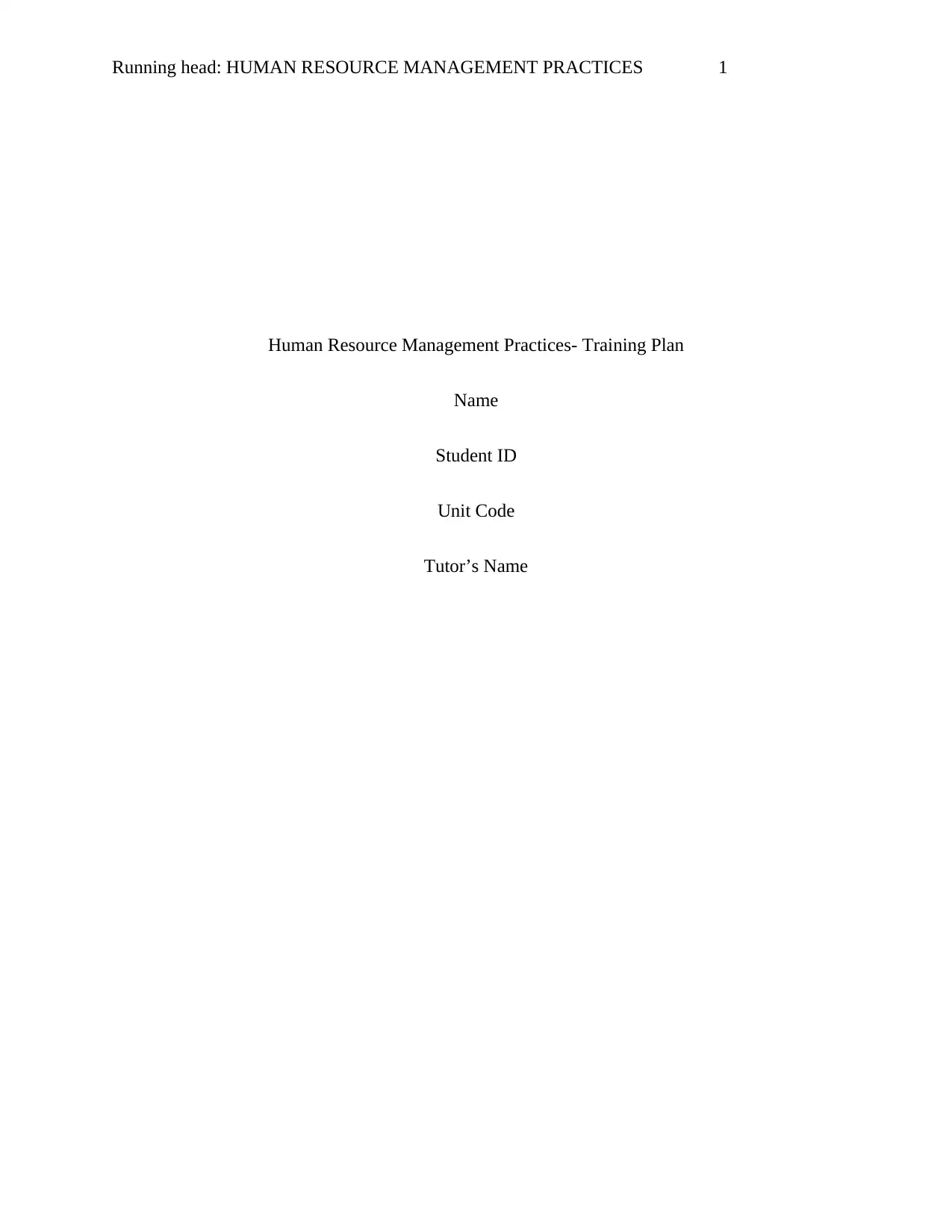
Running head: HUMAN RESOURCE MANAGEMENT PRACTICES 1
Human Resource Management Practices- Training Plan
Name
Student ID
Unit Code
Tutor’s Name
Human Resource Management Practices- Training Plan
Name
Student ID
Unit Code
Tutor’s Name
Paraphrase This Document
Need a fresh take? Get an instant paraphrase of this document with our AI Paraphraser
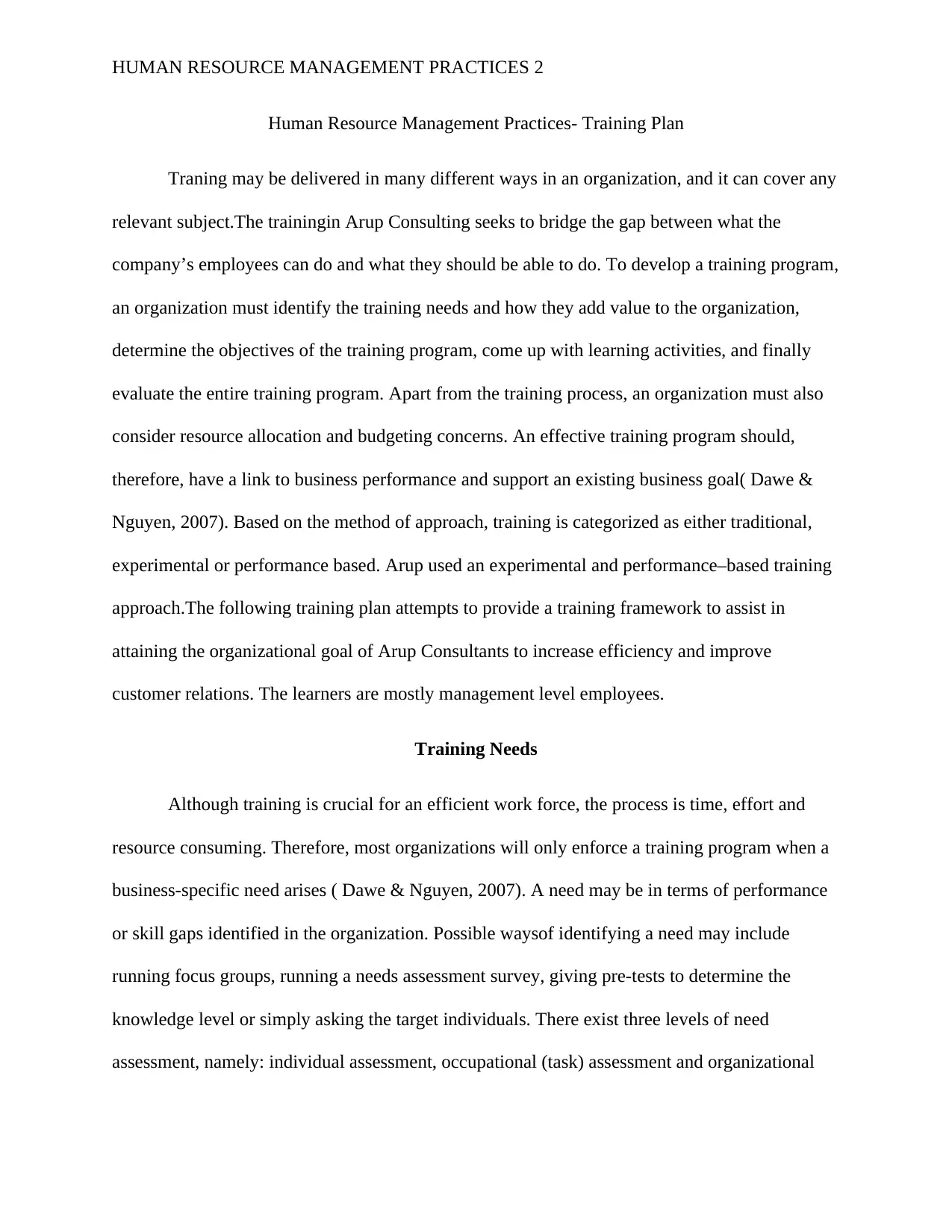
HUMAN RESOURCE MANAGEMENT PRACTICES 2
Human Resource Management Practices- Training Plan
Traning may be delivered in many different ways in an organization, and it can cover any
relevant subject.The trainingin Arup Consulting seeks to bridge the gap between what the
company’s employees can do and what they should be able to do. To develop a training program,
an organization must identify the training needs and how they add value to the organization,
determine the objectives of the training program, come up with learning activities, and finally
evaluate the entire training program. Apart from the training process, an organization must also
consider resource allocation and budgeting concerns. An effective training program should,
therefore, have a link to business performance and support an existing business goal( Dawe &
Nguyen, 2007). Based on the method of approach, training is categorized as either traditional,
experimental or performance based. Arup used an experimental and performance–based training
approach.The following training plan attempts to provide a training framework to assist in
attaining the organizational goal of Arup Consultants to increase efficiency and improve
customer relations. The learners are mostly management level employees.
Training Needs
Although training is crucial for an efficient work force, the process is time, effort and
resource consuming. Therefore, most organizations will only enforce a training program when a
business-specific need arises ( Dawe & Nguyen, 2007). A need may be in terms of performance
or skill gaps identified in the organization. Possible waysof identifying a need may include
running focus groups, running a needs assessment survey, giving pre-tests to determine the
knowledge level or simply asking the target individuals. There exist three levels of need
assessment, namely: individual assessment, occupational (task) assessment and organizational
Human Resource Management Practices- Training Plan
Traning may be delivered in many different ways in an organization, and it can cover any
relevant subject.The trainingin Arup Consulting seeks to bridge the gap between what the
company’s employees can do and what they should be able to do. To develop a training program,
an organization must identify the training needs and how they add value to the organization,
determine the objectives of the training program, come up with learning activities, and finally
evaluate the entire training program. Apart from the training process, an organization must also
consider resource allocation and budgeting concerns. An effective training program should,
therefore, have a link to business performance and support an existing business goal( Dawe &
Nguyen, 2007). Based on the method of approach, training is categorized as either traditional,
experimental or performance based. Arup used an experimental and performance–based training
approach.The following training plan attempts to provide a training framework to assist in
attaining the organizational goal of Arup Consultants to increase efficiency and improve
customer relations. The learners are mostly management level employees.
Training Needs
Although training is crucial for an efficient work force, the process is time, effort and
resource consuming. Therefore, most organizations will only enforce a training program when a
business-specific need arises ( Dawe & Nguyen, 2007). A need may be in terms of performance
or skill gaps identified in the organization. Possible waysof identifying a need may include
running focus groups, running a needs assessment survey, giving pre-tests to determine the
knowledge level or simply asking the target individuals. There exist three levels of need
assessment, namely: individual assessment, occupational (task) assessment and organizational
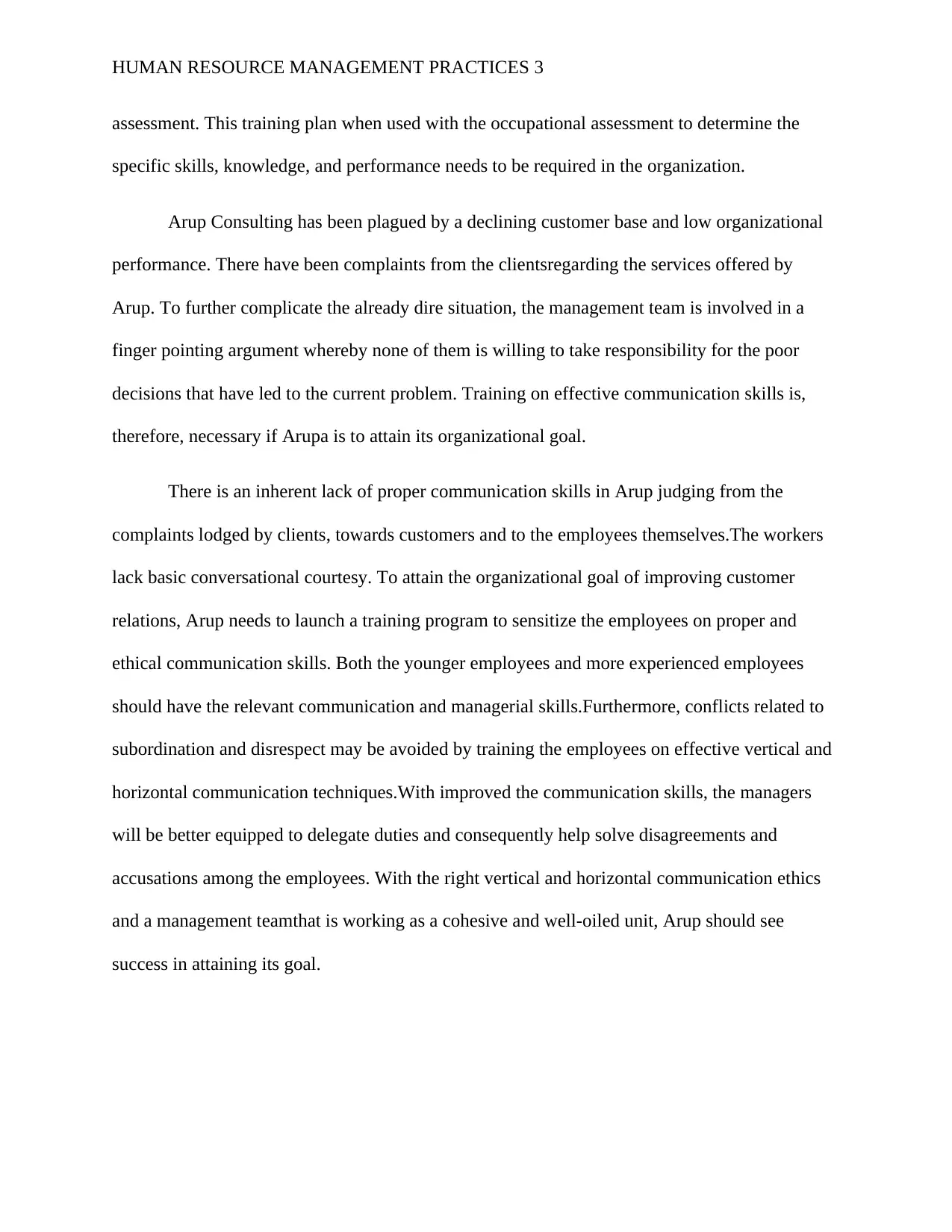
HUMAN RESOURCE MANAGEMENT PRACTICES 3
assessment. This training plan when used with the occupational assessment to determine the
specific skills, knowledge, and performance needs to be required in the organization.
Arup Consulting has been plagued by a declining customer base and low organizational
performance. There have been complaints from the clientsregarding the services offered by
Arup. To further complicate the already dire situation, the management team is involved in a
finger pointing argument whereby none of them is willing to take responsibility for the poor
decisions that have led to the current problem. Training on effective communication skills is,
therefore, necessary if Arupa is to attain its organizational goal.
There is an inherent lack of proper communication skills in Arup judging from the
complaints lodged by clients, towards customers and to the employees themselves.The workers
lack basic conversational courtesy. To attain the organizational goal of improving customer
relations, Arup needs to launch a training program to sensitize the employees on proper and
ethical communication skills. Both the younger employees and more experienced employees
should have the relevant communication and managerial skills.Furthermore, conflicts related to
subordination and disrespect may be avoided by training the employees on effective vertical and
horizontal communication techniques.With improved the communication skills, the managers
will be better equipped to delegate duties and consequently help solve disagreements and
accusations among the employees. With the right vertical and horizontal communication ethics
and a management teamthat is working as a cohesive and well-oiled unit, Arup should see
success in attaining its goal.
assessment. This training plan when used with the occupational assessment to determine the
specific skills, knowledge, and performance needs to be required in the organization.
Arup Consulting has been plagued by a declining customer base and low organizational
performance. There have been complaints from the clientsregarding the services offered by
Arup. To further complicate the already dire situation, the management team is involved in a
finger pointing argument whereby none of them is willing to take responsibility for the poor
decisions that have led to the current problem. Training on effective communication skills is,
therefore, necessary if Arupa is to attain its organizational goal.
There is an inherent lack of proper communication skills in Arup judging from the
complaints lodged by clients, towards customers and to the employees themselves.The workers
lack basic conversational courtesy. To attain the organizational goal of improving customer
relations, Arup needs to launch a training program to sensitize the employees on proper and
ethical communication skills. Both the younger employees and more experienced employees
should have the relevant communication and managerial skills.Furthermore, conflicts related to
subordination and disrespect may be avoided by training the employees on effective vertical and
horizontal communication techniques.With improved the communication skills, the managers
will be better equipped to delegate duties and consequently help solve disagreements and
accusations among the employees. With the right vertical and horizontal communication ethics
and a management teamthat is working as a cohesive and well-oiled unit, Arup should see
success in attaining its goal.
⊘ This is a preview!⊘
Do you want full access?
Subscribe today to unlock all pages.

Trusted by 1+ million students worldwide
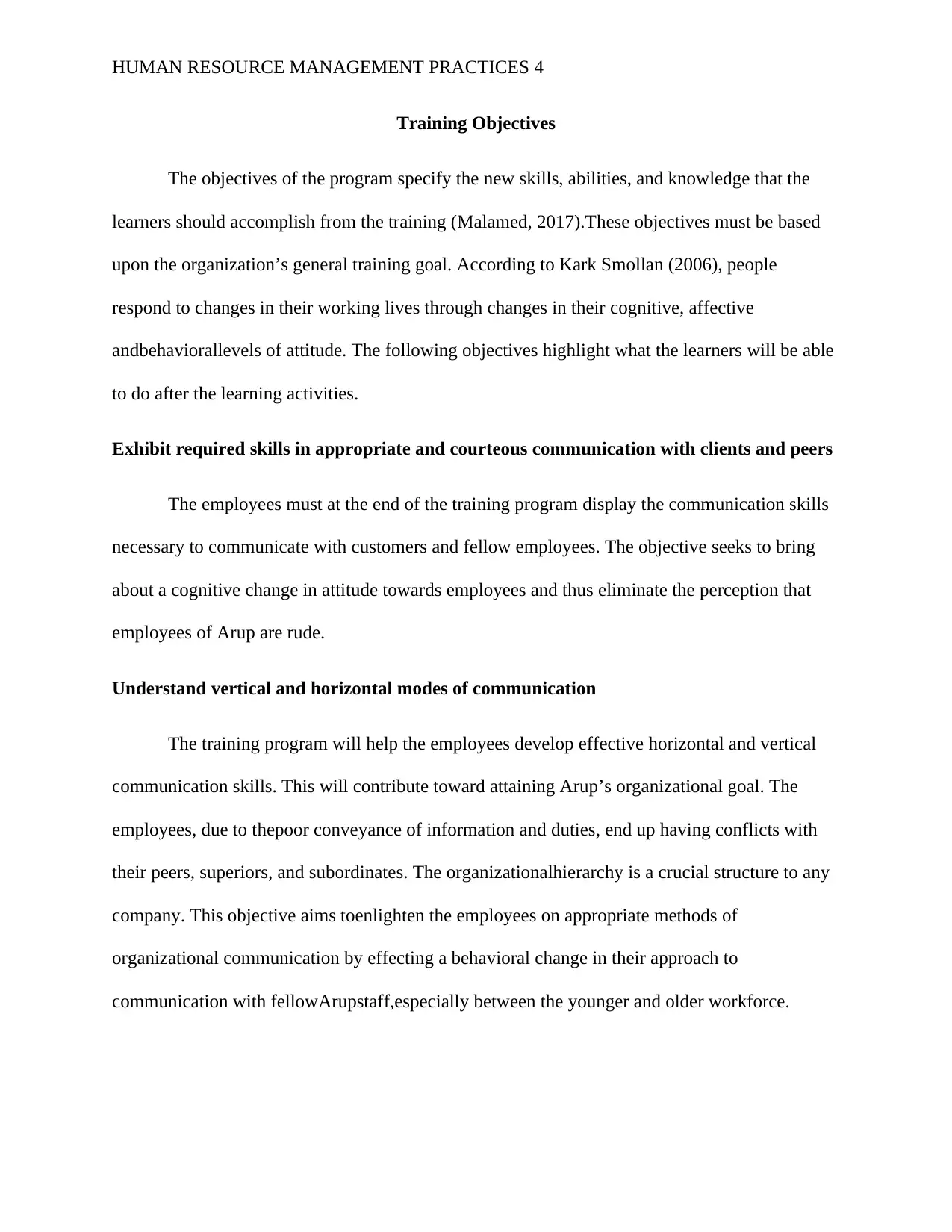
HUMAN RESOURCE MANAGEMENT PRACTICES 4
Training Objectives
The objectives of the program specify the new skills, abilities, and knowledge that the
learners should accomplish from the training (Malamed, 2017).These objectives must be based
upon the organization’s general training goal. According to Kark Smollan (2006), people
respond to changes in their working lives through changes in their cognitive, affective
andbehaviorallevels of attitude. The following objectives highlight what the learners will be able
to do after the learning activities.
Exhibit required skills in appropriate and courteous communication with clients and peers
The employees must at the end of the training program display the communication skills
necessary to communicate with customers and fellow employees. The objective seeks to bring
about a cognitive change in attitude towards employees and thus eliminate the perception that
employees of Arup are rude.
Understand vertical and horizontal modes of communication
The training program will help the employees develop effective horizontal and vertical
communication skills. This will contribute toward attaining Arup’s organizational goal. The
employees, due to thepoor conveyance of information and duties, end up having conflicts with
their peers, superiors, and subordinates. The organizationalhierarchy is a crucial structure to any
company. This objective aims toenlighten the employees on appropriate methods of
organizational communication by effecting a behavioral change in their approach to
communication with fellowArupstaff,especially between the younger and older workforce.
Training Objectives
The objectives of the program specify the new skills, abilities, and knowledge that the
learners should accomplish from the training (Malamed, 2017).These objectives must be based
upon the organization’s general training goal. According to Kark Smollan (2006), people
respond to changes in their working lives through changes in their cognitive, affective
andbehaviorallevels of attitude. The following objectives highlight what the learners will be able
to do after the learning activities.
Exhibit required skills in appropriate and courteous communication with clients and peers
The employees must at the end of the training program display the communication skills
necessary to communicate with customers and fellow employees. The objective seeks to bring
about a cognitive change in attitude towards employees and thus eliminate the perception that
employees of Arup are rude.
Understand vertical and horizontal modes of communication
The training program will help the employees develop effective horizontal and vertical
communication skills. This will contribute toward attaining Arup’s organizational goal. The
employees, due to thepoor conveyance of information and duties, end up having conflicts with
their peers, superiors, and subordinates. The organizationalhierarchy is a crucial structure to any
company. This objective aims toenlighten the employees on appropriate methods of
organizational communication by effecting a behavioral change in their approach to
communication with fellowArupstaff,especially between the younger and older workforce.
Paraphrase This Document
Need a fresh take? Get an instant paraphrase of this document with our AI Paraphraser
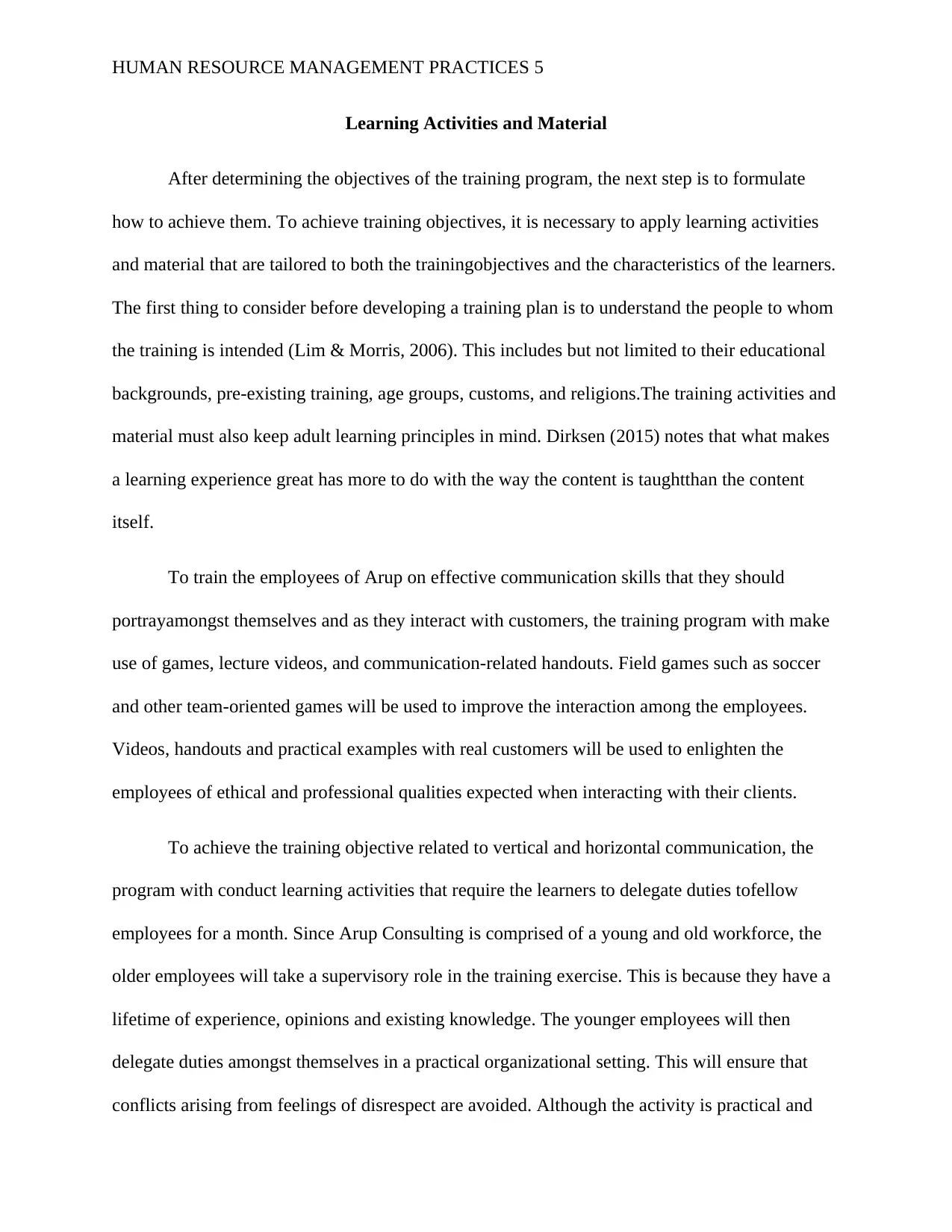
HUMAN RESOURCE MANAGEMENT PRACTICES 5
Learning Activities and Material
After determining the objectives of the training program, the next step is to formulate
how to achieve them. To achieve training objectives, it is necessary to apply learning activities
and material that are tailored to both the trainingobjectives and the characteristics of the learners.
The first thing to consider before developing a training plan is to understand the people to whom
the training is intended (Lim & Morris, 2006). This includes but not limited to their educational
backgrounds, pre-existing training, age groups, customs, and religions.The training activities and
material must also keep adult learning principles in mind. Dirksen (2015) notes that what makes
a learning experience great has more to do with the way the content is taughtthan the content
itself.
To train the employees of Arup on effective communication skills that they should
portrayamongst themselves and as they interact with customers, the training program with make
use of games, lecture videos, and communication-related handouts. Field games such as soccer
and other team-oriented games will be used to improve the interaction among the employees.
Videos, handouts and practical examples with real customers will be used to enlighten the
employees of ethical and professional qualities expected when interacting with their clients.
To achieve the training objective related to vertical and horizontal communication, the
program with conduct learning activities that require the learners to delegate duties tofellow
employees for a month. Since Arup Consulting is comprised of a young and old workforce, the
older employees will take a supervisory role in the training exercise. This is because they have a
lifetime of experience, opinions and existing knowledge. The younger employees will then
delegate duties amongst themselves in a practical organizational setting. This will ensure that
conflicts arising from feelings of disrespect are avoided. Although the activity is practical and
Learning Activities and Material
After determining the objectives of the training program, the next step is to formulate
how to achieve them. To achieve training objectives, it is necessary to apply learning activities
and material that are tailored to both the trainingobjectives and the characteristics of the learners.
The first thing to consider before developing a training plan is to understand the people to whom
the training is intended (Lim & Morris, 2006). This includes but not limited to their educational
backgrounds, pre-existing training, age groups, customs, and religions.The training activities and
material must also keep adult learning principles in mind. Dirksen (2015) notes that what makes
a learning experience great has more to do with the way the content is taughtthan the content
itself.
To train the employees of Arup on effective communication skills that they should
portrayamongst themselves and as they interact with customers, the training program with make
use of games, lecture videos, and communication-related handouts. Field games such as soccer
and other team-oriented games will be used to improve the interaction among the employees.
Videos, handouts and practical examples with real customers will be used to enlighten the
employees of ethical and professional qualities expected when interacting with their clients.
To achieve the training objective related to vertical and horizontal communication, the
program with conduct learning activities that require the learners to delegate duties tofellow
employees for a month. Since Arup Consulting is comprised of a young and old workforce, the
older employees will take a supervisory role in the training exercise. This is because they have a
lifetime of experience, opinions and existing knowledge. The younger employees will then
delegate duties amongst themselves in a practical organizational setting. This will ensure that
conflicts arising from feelings of disrespect are avoided. Although the activity is practical and
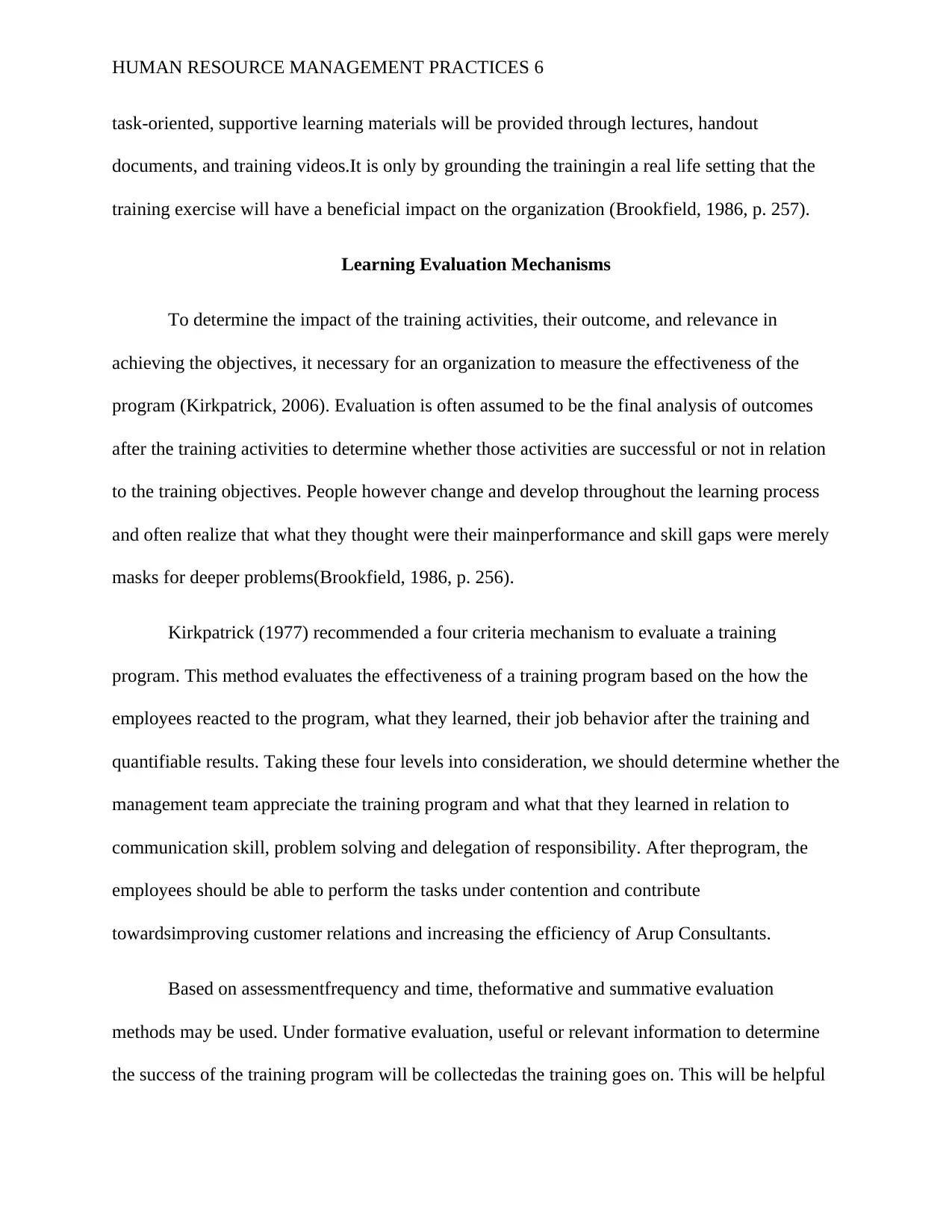
HUMAN RESOURCE MANAGEMENT PRACTICES 6
task-oriented, supportive learning materials will be provided through lectures, handout
documents, and training videos.It is only by grounding the trainingin a real life setting that the
training exercise will have a beneficial impact on the organization (Brookfield, 1986, p. 257).
Learning Evaluation Mechanisms
To determine the impact of the training activities, their outcome, and relevance in
achieving the objectives, it necessary for an organization to measure the effectiveness of the
program (Kirkpatrick, 2006). Evaluation is often assumed to be the final analysis of outcomes
after the training activities to determine whether those activities are successful or not in relation
to the training objectives. People however change and develop throughout the learning process
and often realize that what they thought were their mainperformance and skill gaps were merely
masks for deeper problems(Brookfield, 1986, p. 256).
Kirkpatrick (1977) recommended a four criteria mechanism to evaluate a training
program. This method evaluates the effectiveness of a training program based on the how the
employees reacted to the program, what they learned, their job behavior after the training and
quantifiable results. Taking these four levels into consideration, we should determine whether the
management team appreciate the training program and what that they learned in relation to
communication skill, problem solving and delegation of responsibility. After theprogram, the
employees should be able to perform the tasks under contention and contribute
towardsimproving customer relations and increasing the efficiency of Arup Consultants.
Based on assessmentfrequency and time, theformative and summative evaluation
methods may be used. Under formative evaluation, useful or relevant information to determine
the success of the training program will be collectedas the training goes on. This will be helpful
task-oriented, supportive learning materials will be provided through lectures, handout
documents, and training videos.It is only by grounding the trainingin a real life setting that the
training exercise will have a beneficial impact on the organization (Brookfield, 1986, p. 257).
Learning Evaluation Mechanisms
To determine the impact of the training activities, their outcome, and relevance in
achieving the objectives, it necessary for an organization to measure the effectiveness of the
program (Kirkpatrick, 2006). Evaluation is often assumed to be the final analysis of outcomes
after the training activities to determine whether those activities are successful or not in relation
to the training objectives. People however change and develop throughout the learning process
and often realize that what they thought were their mainperformance and skill gaps were merely
masks for deeper problems(Brookfield, 1986, p. 256).
Kirkpatrick (1977) recommended a four criteria mechanism to evaluate a training
program. This method evaluates the effectiveness of a training program based on the how the
employees reacted to the program, what they learned, their job behavior after the training and
quantifiable results. Taking these four levels into consideration, we should determine whether the
management team appreciate the training program and what that they learned in relation to
communication skill, problem solving and delegation of responsibility. After theprogram, the
employees should be able to perform the tasks under contention and contribute
towardsimproving customer relations and increasing the efficiency of Arup Consultants.
Based on assessmentfrequency and time, theformative and summative evaluation
methods may be used. Under formative evaluation, useful or relevant information to determine
the success of the training program will be collectedas the training goes on. This will be helpful
⊘ This is a preview!⊘
Do you want full access?
Subscribe today to unlock all pages.

Trusted by 1+ million students worldwide
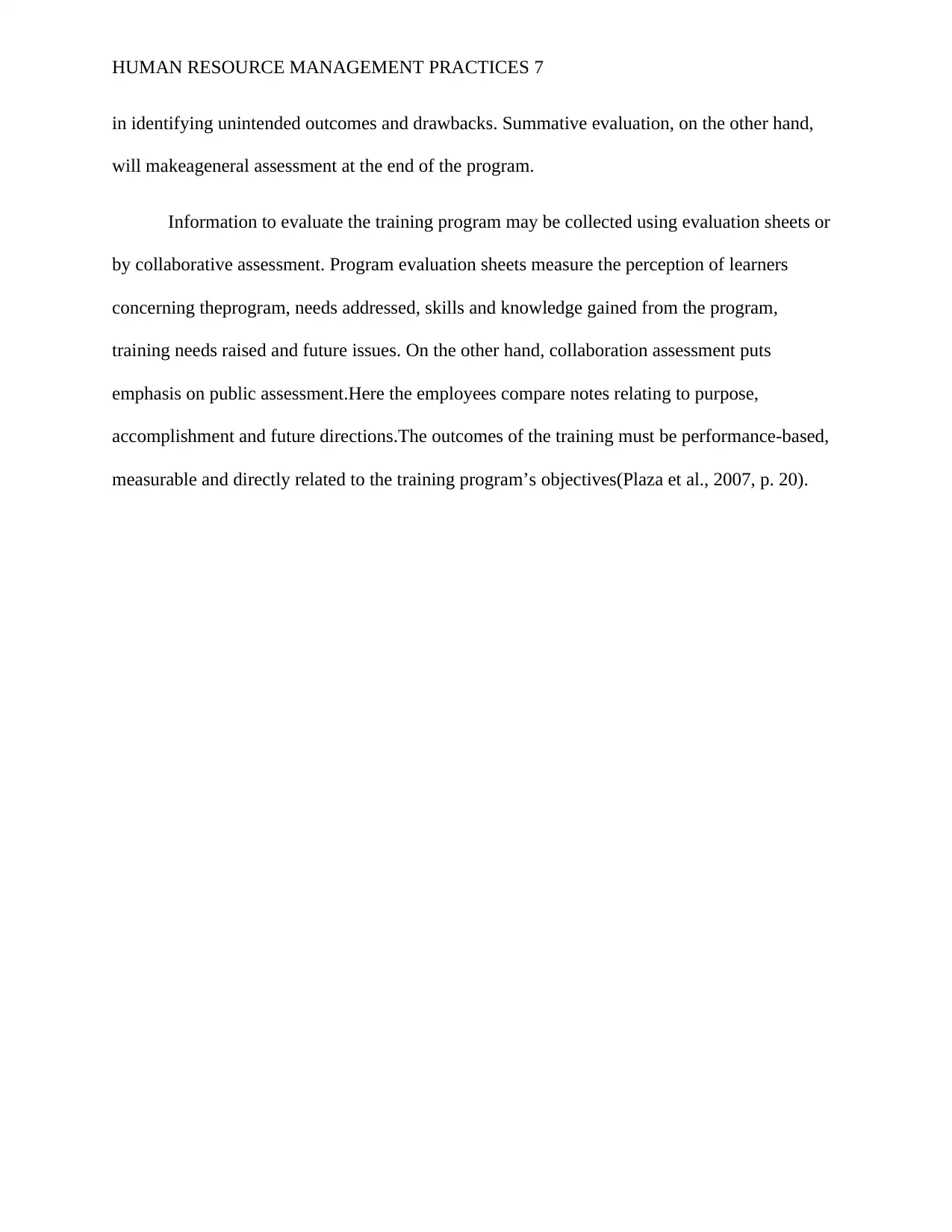
HUMAN RESOURCE MANAGEMENT PRACTICES 7
in identifying unintended outcomes and drawbacks. Summative evaluation, on the other hand,
will makeageneral assessment at the end of the program.
Information to evaluate the training program may be collected using evaluation sheets or
by collaborative assessment. Program evaluation sheets measure the perception of learners
concerning theprogram, needs addressed, skills and knowledge gained from the program,
training needs raised and future issues. On the other hand, collaboration assessment puts
emphasis on public assessment.Here the employees compare notes relating to purpose,
accomplishment and future directions.The outcomes of the training must be performance-based,
measurable and directly related to the training program’s objectives(Plaza et al., 2007, p. 20).
in identifying unintended outcomes and drawbacks. Summative evaluation, on the other hand,
will makeageneral assessment at the end of the program.
Information to evaluate the training program may be collected using evaluation sheets or
by collaborative assessment. Program evaluation sheets measure the perception of learners
concerning theprogram, needs addressed, skills and knowledge gained from the program,
training needs raised and future issues. On the other hand, collaboration assessment puts
emphasis on public assessment.Here the employees compare notes relating to purpose,
accomplishment and future directions.The outcomes of the training must be performance-based,
measurable and directly related to the training program’s objectives(Plaza et al., 2007, p. 20).
Paraphrase This Document
Need a fresh take? Get an instant paraphrase of this document with our AI Paraphraser
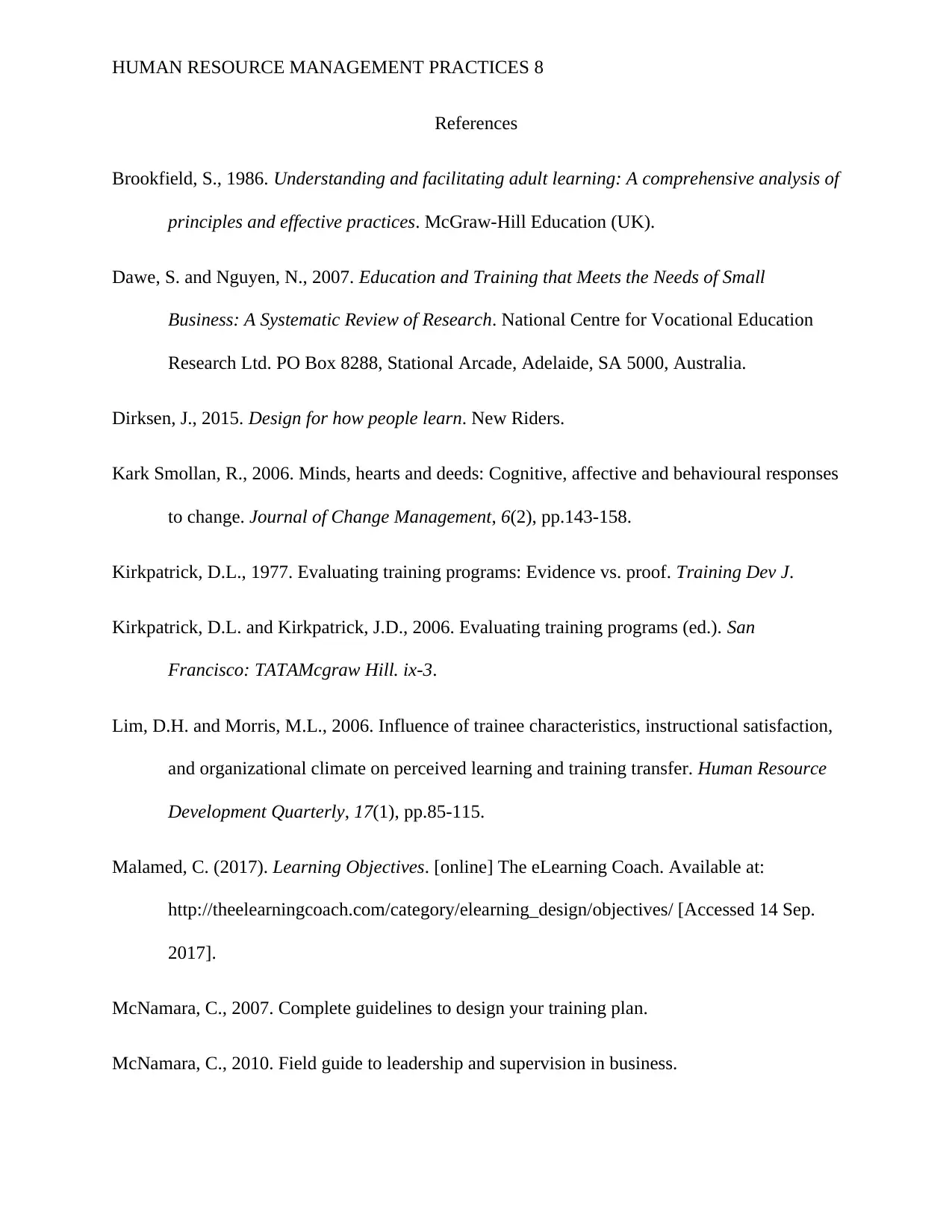
HUMAN RESOURCE MANAGEMENT PRACTICES 8
References
Brookfield, S., 1986. Understanding and facilitating adult learning: A comprehensive analysis of
principles and effective practices. McGraw-Hill Education (UK).
Dawe, S. and Nguyen, N., 2007. Education and Training that Meets the Needs of Small
Business: A Systematic Review of Research. National Centre for Vocational Education
Research Ltd. PO Box 8288, Stational Arcade, Adelaide, SA 5000, Australia.
Dirksen, J., 2015. Design for how people learn. New Riders.
Kark Smollan, R., 2006. Minds, hearts and deeds: Cognitive, affective and behavioural responses
to change. Journal of Change Management, 6(2), pp.143-158.
Kirkpatrick, D.L., 1977. Evaluating training programs: Evidence vs. proof. Training Dev J.
Kirkpatrick, D.L. and Kirkpatrick, J.D., 2006. Evaluating training programs (ed.). San
Francisco: TATAMcgraw Hill. ix-3.
Lim, D.H. and Morris, M.L., 2006. Influence of trainee characteristics, instructional satisfaction,
and organizational climate on perceived learning and training transfer. Human Resource
Development Quarterly, 17(1), pp.85-115.
Malamed, C. (2017). Learning Objectives. [online] The eLearning Coach. Available at:
http://theelearningcoach.com/category/elearning_design/objectives/ [Accessed 14 Sep.
2017].
McNamara, C., 2007. Complete guidelines to design your training plan.
McNamara, C., 2010. Field guide to leadership and supervision in business.
References
Brookfield, S., 1986. Understanding and facilitating adult learning: A comprehensive analysis of
principles and effective practices. McGraw-Hill Education (UK).
Dawe, S. and Nguyen, N., 2007. Education and Training that Meets the Needs of Small
Business: A Systematic Review of Research. National Centre for Vocational Education
Research Ltd. PO Box 8288, Stational Arcade, Adelaide, SA 5000, Australia.
Dirksen, J., 2015. Design for how people learn. New Riders.
Kark Smollan, R., 2006. Minds, hearts and deeds: Cognitive, affective and behavioural responses
to change. Journal of Change Management, 6(2), pp.143-158.
Kirkpatrick, D.L., 1977. Evaluating training programs: Evidence vs. proof. Training Dev J.
Kirkpatrick, D.L. and Kirkpatrick, J.D., 2006. Evaluating training programs (ed.). San
Francisco: TATAMcgraw Hill. ix-3.
Lim, D.H. and Morris, M.L., 2006. Influence of trainee characteristics, instructional satisfaction,
and organizational climate on perceived learning and training transfer. Human Resource
Development Quarterly, 17(1), pp.85-115.
Malamed, C. (2017). Learning Objectives. [online] The eLearning Coach. Available at:
http://theelearningcoach.com/category/elearning_design/objectives/ [Accessed 14 Sep.
2017].
McNamara, C., 2007. Complete guidelines to design your training plan.
McNamara, C., 2010. Field guide to leadership and supervision in business.
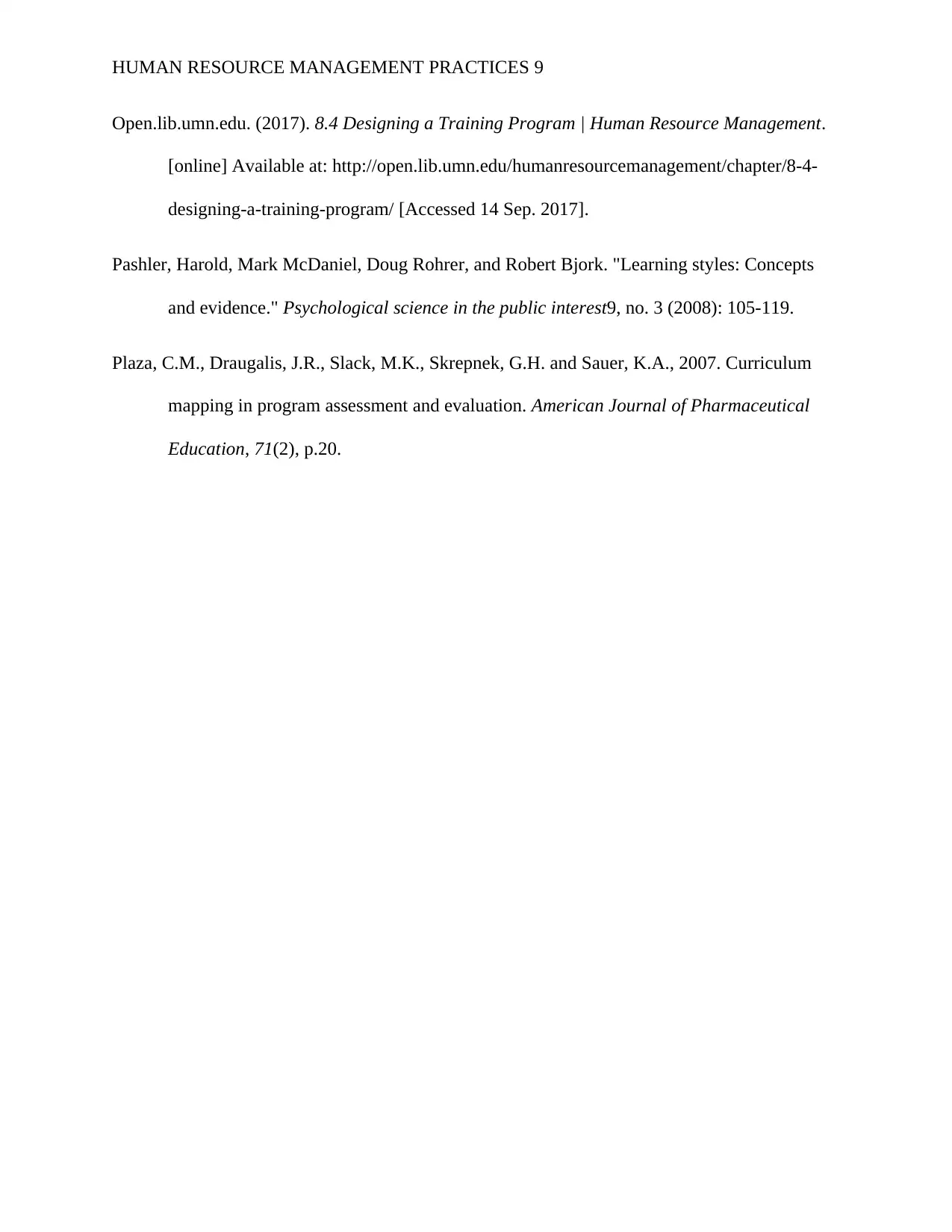
HUMAN RESOURCE MANAGEMENT PRACTICES 9
Open.lib.umn.edu. (2017). 8.4 Designing a Training Program | Human Resource Management.
[online] Available at: http://open.lib.umn.edu/humanresourcemanagement/chapter/8-4-
designing-a-training-program/ [Accessed 14 Sep. 2017].
Pashler, Harold, Mark McDaniel, Doug Rohrer, and Robert Bjork. "Learning styles: Concepts
and evidence." Psychological science in the public interest9, no. 3 (2008): 105-119.
Plaza, C.M., Draugalis, J.R., Slack, M.K., Skrepnek, G.H. and Sauer, K.A., 2007. Curriculum
mapping in program assessment and evaluation. American Journal of Pharmaceutical
Education, 71(2), p.20.
Open.lib.umn.edu. (2017). 8.4 Designing a Training Program | Human Resource Management.
[online] Available at: http://open.lib.umn.edu/humanresourcemanagement/chapter/8-4-
designing-a-training-program/ [Accessed 14 Sep. 2017].
Pashler, Harold, Mark McDaniel, Doug Rohrer, and Robert Bjork. "Learning styles: Concepts
and evidence." Psychological science in the public interest9, no. 3 (2008): 105-119.
Plaza, C.M., Draugalis, J.R., Slack, M.K., Skrepnek, G.H. and Sauer, K.A., 2007. Curriculum
mapping in program assessment and evaluation. American Journal of Pharmaceutical
Education, 71(2), p.20.
⊘ This is a preview!⊘
Do you want full access?
Subscribe today to unlock all pages.

Trusted by 1+ million students worldwide
1 out of 9
Related Documents
Your All-in-One AI-Powered Toolkit for Academic Success.
+13062052269
info@desklib.com
Available 24*7 on WhatsApp / Email
![[object Object]](/_next/static/media/star-bottom.7253800d.svg)
Unlock your academic potential
Copyright © 2020–2025 A2Z Services. All Rights Reserved. Developed and managed by ZUCOL.





